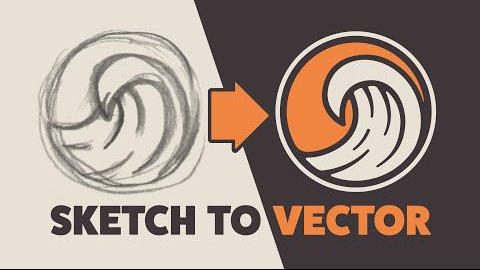Menu

In today’s digital-first world, vector graphics are essential for professional design. Whether you're creating a logo, icon, or custom illustration, vectors offer unmatched flexibility and scalability. But how do you turn an idea into a vector graphic? The process may seem technical, but it’s easier than you think—especially with the right tools and workflow.
In this step-by-step guide, we’ll break it all down so you can confidently transform any sketch, photo, or concept into a clean, editable vector. Even if you’re new to design, this guide will help you go from rough draft to refined vector in no time.
A vector graphic is a digital image made using mathematical paths rather than pixels. This allows it to be scaled to any size without losing quality, making it ideal for professional branding, web, and print applications.
Using vectors in your work ensures that your design assets stay sharp, whether you're printing a billboard or designing a favicon. This is why top platforms like SeekVector offer free access to high-quality vector content for designers and businesses.
Benefits of using vectors:
Scalability – No pixelation, perfect for responsive use
Editability – Modify shapes, text, and colors with ease
Performance – Lightweight for fast website loading
Professionalism – Standard for logos, icons, and illustrations
Popular formats include.SVG, .AI, .PDF, and .EPS.
Before diving into software, define your idea with a hand-drawn sketch or digital outline. This could be on paper, a whiteboard app, or even a photo of something that inspires you.
Ask yourself:
What message should the design communicate?
Should the design be minimalist or detailed?
Will it need to adapt to different platforms?
💡 Tip: Simpler sketches are easier to trace and vectorize.
Need vector inspiration? Browse the free vector collections on SeekVector to see how others start their designs.
The software you choose will shape your workflow. Beginners often prefer browser-based tools, while professionals rely on industry-standard applications.
Inkscape – A powerful, open-source vector editor
Photopea – Works in your browser and supports SVG export.
Vectr – Simple, beginner-friendly vector editing
Adobe Illustrator – The professional choice with deep features
Affinity Designer – A great one-time-purchase alternative
CorelDRAW – Ideal for advanced print designs
For more tools, check out this curated list on SeekVector.
Once you’ve selected your software, import your sketch or raster image (JPEG/PNG) and place it as a guide. Lock it in the background and begin tracing on a new layer.
Use the Pen Tool, Bezier Curves, or Auto-Trace depending on your tool and skill level. Keep the paths simple and clean for best results.
If you’re using Illustrator, check out Adobe’s Image Trace tutorial to get started.
Alt text suggestion for image:
Designer tracing a logo sketch into vector paths using Adobe Illustrator.
Once your basic shapes are traced:
Adjust anchor points for smooth curves.
Apply consistent color schemes based on brand or purpose.
Group related objects and name layers for clarity.
A great resource for picking color palettes is Coolors, which helps create harmonious combinations that work well in vector formats.
On SeekVector's blog, you'll also find tips for improving color usage in vector illustrations.
Choose the right file format based on how you’ll use the design:
.SVG – Best for web and responsive use
.AI / .EPS – Preferred for editing and print
.PDF – Useful for sharing and previews
💡 Always save a working copy in your design software’s native format (e.g., .AI or .AFDESIGN).
For automated conversion, try services like Vectorizer.io or Vector Magic—but be ready to manually clean up paths for professional use.
If you’re in a rush or need structure, start with a pre-built vector template. You can find editable templates for logos, business cards, icons, and infographics on platforms like:
Templates speed up your process while still allowing full customization.
Turning an idea into a vector graphic isn’t just for pros—it’s a creative skill anyone can master with the right tools and process. From the sketch stage to clean SVG export, every step helps you communicate your idea clearly and beautifully.
Whether you're creating a brand logo, an app icon, or custom illustrations, vector graphics give you professional polish and flexibility.
👉 Ready to get started? Explore free vector tools, templates, and design tips at SeekVector